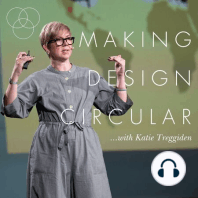31 min listen
Bridget Harvey
ratings:
Length:
42 minutes
Released:
Jun 22, 2021
Format:
Podcast episode
Description
What are the differences between repair, restoration and conservation? Is maintenance also repair? And how are these processes viewed along gender lines? On today’s episode, I’m talking to Bridget Harvey, an artist who uses making to ask critical questions, generate new understanding and add meaning through craft. Investigating processes and concepts through making: she asks what we make, how we make it, and why that matters. We discuss:- What we make, how we make it, and why it matters.- How mending and repair are loaded words with material and gender implications.- The differences in textiles that age well versus those that don't.- The benefits to the planet of repairing lower priced items.- How the circular economy has to be about more than just upcycling.… and more!Here are some highlights. Repair is often multidisciplinary. "I've never felt comfortable to sit just with one material, because I'm always interested in the processes more than the materials themselves. So in trying to understand repair extremely deeply, which is what I've been doing for the last eight years or so, it's just been a natural fact that I will be multidisciplinary. I was before and I still am. Breakage happens across different materials across different objects across different scales. Even breakage itself is really a scale. The idea of just being with one material, just isn't natural for me. And also, one of the things that I've found through my explorations is that you don't necessarily mend an object with the material that it’s made with. So repair quite often by its very nature is in some way, multimedia. Mixing and melding just kind of happens along the way."Using the word repair rather than mending "I tend to use the word repair because it means to make something work as you need it to work. And that is quite important to me because I don't think it needs to go back to exactly how it was, which is the kind of formal definition of mending. And 'restore' is quite a loaded word. I mean, once you start looking at restoration, as opposed to say, conservation or preservation, you know, you start getting into all these areas, which are really sort of lumped together. But actually, they're very different. And the differences are quite important. Once you start digging through them in gender terms, and again, this goes a little bit binary. But that's maybe because the internet is a little bit binary… if you google ‘mending’, you get textiles, and you get women. If you google ‘repair’, you get vehicles, maybe washing machines, and you get men. And that, I think, is inaccurate. So repair work was done by all people on all things. Soldiers mended their clothes and we know men were heavily involved in textile mending."The repair movement“There's a lot of discussion on the right to repair movement. And that idea around something called "optional durability.” You can decide how long your thing lasts, if you don't want to change your phone every year, you're quite happy to keep using it until it properly conks out. A part of that is that ongoing maintenance or care for those objects and that there's those kinds of choices rather than being forced into someone else's timeline, which you can almost guarantee it's not for your good, not for community good, not for planetary good. It's money up and choices out."The visible vs the invisible"They try not to hide conservation work, they try to make it subtle so it doesn't disrupt your view of an object, but not to hide it. The object is viewed as perfect with no life story as per pure restoration. And that, to me, was very interesting with that visible/invisible, because it starts to show you it as a scale rather than a split. And you start to think 'I might not be able to mend this perfectly, but I don't have to make it really in your face visible', you know. I can do it sort of subtly, or decoratively or with some other kind of nuance compared to the original object and material. And that is a really interesting
Released:
Jun 22, 2021
Format:
Podcast episode
Titles in the series (42)
Ander Zabala: Ahead of Zero Waste Week next week, the fourth episode of Series 01 is a conversation between Katie Treggiden and ‘Zero Waste Warrior’ Ander Zabala (@goxuboys on Instagram), who can fit his weekly household waste into a single jam jar. They talk about how Ander found his calling while still at school, the importance of making waste visible, and how starting small can produce big results. As recommended by Metro, The Week, Wallpaper and FastCompany. by Making Design Circular with Katie Treggiden
